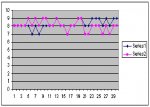keterys
First Post
Just so someone says it... a 55% chance to hit is needing a 10 on the die. It's an interesting choice for baseline as it matches the save mechanic, the double digit point on the die, etc. It makes it a lot easier to get a good feel for what hits and doesn't very quickly as you see the die lands.
Also, when considering a 'difficult to hit opponent' such as a higher level elite or solo, what should its chance to be hit be before it uses, say, concealment, blindness, or penalties to attack?
For example, a Black Dragon can not only blind many of the PC attackers in effect, it can also impose a -2 penalty to attacks from dragon fear.
Also, when considering a 'difficult to hit opponent' such as a higher level elite or solo, what should its chance to be hit be before it uses, say, concealment, blindness, or penalties to attack?
For example, a Black Dragon can not only blind many of the PC attackers in effect, it can also impose a -2 penalty to attacks from dragon fear.




